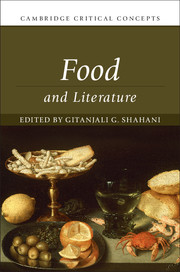Book contents
- Food and Literature
- Cambridge Critical Concepts
- Food and Literature
- Copyright page
- Contents
- Notes on Contributors
- Introduction
- Part I Origins
- Chapter 1 Commensality
- Chapter 2 The Drive-Thru Supermarket
- Chapter 3 Gothic Vegetarianism
- Chapter 4 Good Taste, Good Food, and the Gastronome
- Chapter 5 The Art of the Recipe
- Chapter 6 Existential Disgust and the Food of the Philosopher
- Part II Developments
- Part III Applications
- Afterword
- Index
- Cambridge Critical Concepts (continued from page iii)
- References
Chapter 6 - Existential Disgust and the Food of the Philosopher
from Part I - Origins
Published online by Cambridge University Press: 26 June 2018
- Food and Literature
- Cambridge Critical Concepts
- Food and Literature
- Copyright page
- Contents
- Notes on Contributors
- Introduction
- Part I Origins
- Chapter 1 Commensality
- Chapter 2 The Drive-Thru Supermarket
- Chapter 3 Gothic Vegetarianism
- Chapter 4 Good Taste, Good Food, and the Gastronome
- Chapter 5 The Art of the Recipe
- Chapter 6 Existential Disgust and the Food of the Philosopher
- Part II Developments
- Part III Applications
- Afterword
- Index
- Cambridge Critical Concepts (continued from page iii)
- References
Summary
- Type
- Chapter
- Information
- Food and Literature , pp. 130 - 144Publisher: Cambridge University PressPrint publication year: 2018

